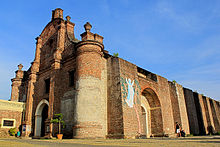Our Lady of the Assumption Church (Santa Maria, Ilocos Sur)
| Santa Maria Church | |
|---|---|
| Our Lady of the Assumption Parish Church | |
| Iglesia de Nuestra Senora de la Asuncion | |

A quarter view of Santa Maria Church showing the facade and buttresses
|
|
| 17°22′0″N 120°28′59.2″E / 17.36667°N 120.483111°ECoordinates: 17°22′0″N 120°28′59.2″E / 17.36667°N 120.483111°E | |
| Location | Santa Maria, Ilocos Sur |
| Country | Philippines |
| Denomination | Roman Catholic |
| Architecture | |
| Status | Parish church |
| Functional status | Active |
| Heritage designation | UNESCO World Heritage Site |
| Designated | 1993 |
| Architectural type | Church |
| Style | Earthquake Baroque |
| Groundbreaking | 1765 |
| Specifications | |
| Length | 99 meters (325 ft) wide. |
| Width | 22.7 meters (74 ft) |
| Number of floors | Two |
| Number of domes | None |
| Number of towers | One |
| Materials | Brick |
| Administration | |
| Archdiocese | Nueva Segovia |
| Clergy | |
| Archbishop | Marlo Mendoza Peralta |
|
|||||
| UNESCO World Heritage Site | |||||
|---|---|---|---|---|---|
| Location |
Philippines |
||||
| Criteria | ii, iv | ||||
| Reference | 677 | ||||
| Coordinates | 17°21′59″N 120°28′59″E / 17.36642°N 120.48305°E | ||||
| Inscription | 1993 (17th Session) | ||||
|
[]
|
|||||
The Church of Our Lady of the Assumption (Nuestra Señora de la Asuncion), commonly known as the Santa Maria Church is the parish church of Santa Maria in Ilocos Sur province, Philippines. The church was designated as a UNESCO World Heritage Site on December 11, 1993 as part of the Baroque Churches of the Philippines, a collection of four Baroque Spanish-era churches.
The Santa Maria Church is an attraction to both tourists and Catholics in Ilocos Sur. It is not only a reminiscent of the four centuries of Spanish domination of that area but also a unique structure with a diversified architectural design of bricks and mortar. It was built on top of a hill not only as a lookout and a citadel but as a religious center during the early administration of the region by both the friars and soldiers of Spain.
The parish of Santa Maria started as a chapel-of-ease (visita) of Narvacan, its neighboring town to the north, in 1567. The influx of the settlers after the full conquest of the Ilocos Region by the Spaniards greatly increased the population of Santa Maria. The chapel became an independent ministry in 1769 and was dedicated to the Virgin Mary depicted as Our Lady of the Assumption. Besides economic progress, evangelical missions were expanded. The mission at Santa Maria, located on a narrow flat plain between the sea and the central mountain range of Luzon, close to the interior settlements, made Santa Maria as the center of both the religious and commercial activities.
According to the legend, before the Santa Maria Church was built on its present site, the Virgin Mary was enshrined at a different place called Bulala. The frequent disappearance of the Virgin Mary from her previous place of enthronement only to be found perched on a guava tree that grew where the present church is located, had led the townspeople to move the church to its present location.
...
Wikipedia






